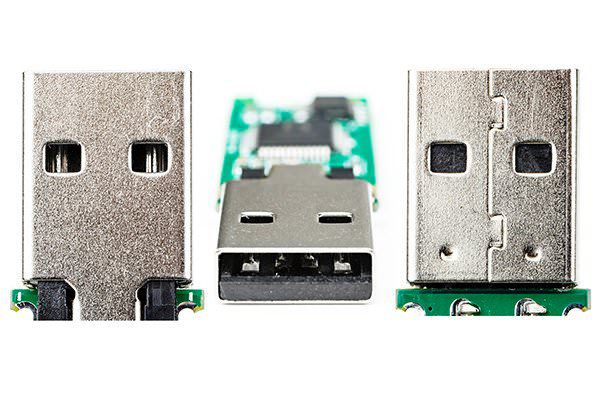Have you ever wondered what’s inside a USB? You may not have the means or the time to crack open a flash drive and see what’s inside, but we do. We’ve taken apart our fair share of flash drives and seen what makes them tick.
Let’s break down what’s inside a USB drive.

Essential Components
All USB drives are comprised of five essential components. These five components are:
- Standard USB Plug
- USB Mass Storage Controller
- NAND Flash Memory Chip
- Crystal Oscillator
- Cover

Standard USB Plug
This is the external part of the drive that forms a physical connection with the host (your computer, or other compatible device). They tend to be flat and rectangular in shape. The “male” part of the USB connector that slides into the computer is called a plug; the female connector that can link to other cables and devices is called the port (though sometimes it’s called the receptacle).
Most USB plugs are Standard-A connectors. These are the classic USB Type A devices. Plugs are also available as Type-B, Mini-USB, Micro-USB, and USB Type-C.

USB Mass Storage Controller
This is a small microcontroller inside the USB that makes your device accessible to a host’s system, enabling file transfers between the host and USB device. The microcontroller is essentially a middleman facilitating the data transfer. It contains a small amount of on-chip ROM and RAM.
A Quick Note on ROM and RAM…
Both ROM and RAM chips deal with data storage, but there’s a crucial difference between them: ROM is non-volatile storage while RAM is volatile storage. If both were volatile, your flash drive wouldn’t be able to hold onto your data. In order to retain information, volatile storage requires a constant power source. When the power is off or the device is pulled out of a host, the RAM chip loses any information stored on it. ROM, however, as a non-volatile chip retains the data regardless of whether or not it is connected to a power source.

NAND Flash Memory Chip
NAND flash memory is another form of non-volatile data storage. The NAND chip in USB drives is the backbone of the device, giving it the power and storage space it needs to hold onto your information. This is where all your documents and files are stored.

Crystal Oscillator
This part of the USB drive controls the flow of information within the USB drive. It uses a 12 MHz clock signal to control the device’s output. All electronic devices use a clock signal. The signal functions in a manner similar to a pendulum, oscillating from one end to the other. This signal helps coordinates the actions of all the electronics on the USB drive.

Cover
This is the “body” of the USB drive. It is the hard outer shell that protects the “guts” of the drive. It’s also the part of the USB drive that can be customized and styled to give USB drives their distinctive appearances. These generally are made of plastic but can be made out of other types of materials, such as metal.

Additional Components
All USB drives contain those five essential parts, but they also occasionally contain additional components that add extra features and functionality to your USB drive.
LEDs
Some drives come with LED indicator lights. These are handy for quickly seeing if your drive is in use or being charged. LEDs are a great way to quickly and accurately monitor the status of your drive of data transfers.

Unpopulated Space
Drives can also sometimes come with additional room inside the drive. That extra space is usually left open so a second memory chip can be added to bulk up the storage capacities of the drive.
Transport Aid
Consider this the “convenience” component. This is the part of the USB that makes it easy to carry around. It can be a keyhole or built-in loop, a key ring, or anything else that makes it possible to clip or attach your USB for transportation.
USB Connector Cap
Some drives include a USB connector cover or cap to offer additional protection for your flash drive. These caps are designed to cover the open plugs of your USB drives, preventing dust or other damaging particles from getting inside. USB drives can also include swivel covers to protect your connectors. Sometimes the cap can be the cover of the USB itself, if the connectors are retractable from inside the body of the drive. There are lots of different ways to access the plugs, either through slide, flip, cap, or swivel mechanics.
Write-Protect Switches
This is an added security feature for USB drives. Write-protect switches are a way to safeguard and preserve the integrity of your data. The switches can enable or disable the writing of data into memory. So, for example, if you were to plug your USB into a potentially unreliable source, you could switch on write-protect mode to prevent additional data from getting onto your USB drive.
Jumpers/Test Pins
These are used for testing during the manufacturing of certain USB drives. They’re used to test for flaws, as well as to ensure that everything inside the USB drive is working properly. They also help load code onto the drive’s microcontroller during the manufacturing process. If your drive is missing test pins or jumpers, don’t worry about it: not all models need or use them.
And that’s really it. 5 components, plus or minus a few extras to customize your data storage experience. There’s a USB drive out there for you, no matter what you need.
